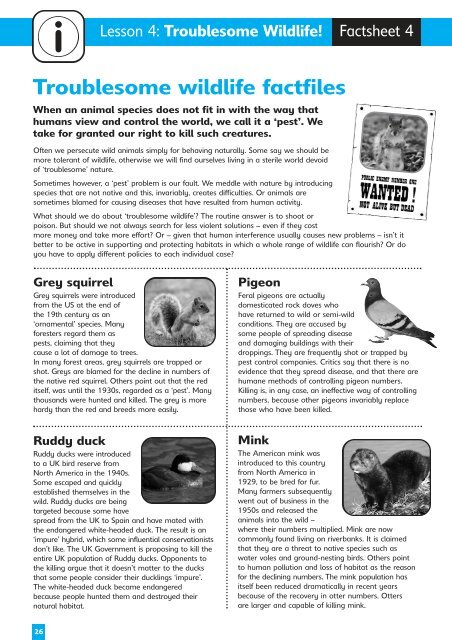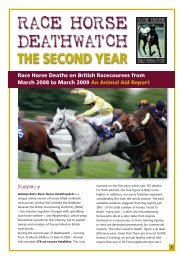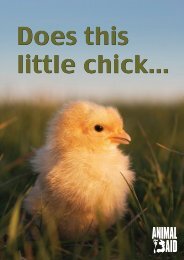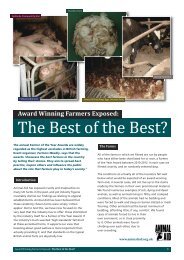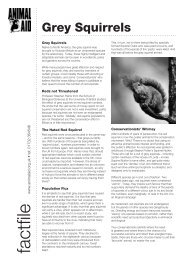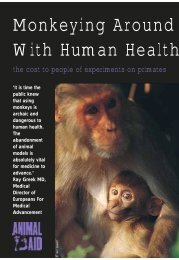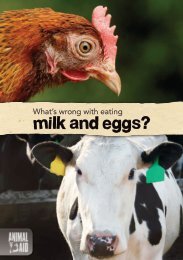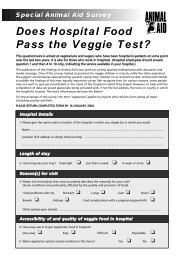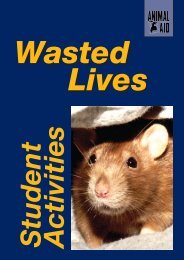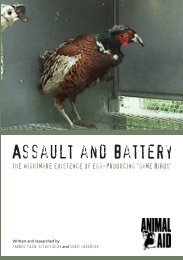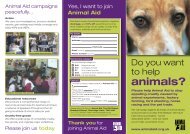English Resource Booklet 2 - Animal Aid
English Resource Booklet 2 - Animal Aid
English Resource Booklet 2 - Animal Aid
You also want an ePaper? Increase the reach of your titles
YUMPU automatically turns print PDFs into web optimized ePapers that Google loves.
iLesson 4: 1: Troublesome Literary <strong>Animal</strong>s Wildlife! Factsheet 4Troublesome wildlife factfilesWhen an animal species does not fit in with the way thathumans view and control the world, we call it a ‘pest’. Wetake for granted our right to kill such creatures.Often we persecute wild animals simply for behaving naturally. Some say we should bemore tolerant of wildlife, otherwise we will find ourselves living in a sterile world devoidof ‘troublesome’ nature.Sometimes however, a ‘pest’ problem is our fault. We meddle with nature by introducingspecies that are not native and this, invariably, creates difficulties. Or animals aresometimes blamed for causing diseases that have resulted from human activity.What should we do about ‘troublesome wildlife’? The routine answer is to shoot orpoison. But should we not always search for less violent solutions – even if they costmore money and take more effort? Or – given that human interference usually causes new problems – isn’t itbetter to be active in supporting and protecting habitats in which a whole range of wildlife can flourish? Or doyou have to apply different policies to each individual case?Grey squirrelGrey squirrels were introducedfrom the US at the end ofthe 19th century as an‘ornamental’ species. Manyforesters regard them aspests, claiming that theycause a lot of damage to trees.In many forest areas, grey squirrels are trapped orshot. Greys are blamed for the decline in numbers ofthe native red squirrel. Others point out that the reditself, was until the 1930s, regarded as a ‘pest’. Manythousands were hunted and killed. The grey is morehardy than the red and breeds more easily.PigeonFeral pigeons are actuallydomesticated rock doves whohave returned to wild or semi-wildconditions. They are accused bysome people of spreading diseaseand damaging buildings with theirdroppings. They are frequently shot or trapped bypest control companies. Critics say that there is noevidence that they spread disease, and that there arehumane methods of controlling pigeon numbers.Killing is, in any case, an ineffective way of controllingnumbers, because other pigeons invariably replacethose who have been killed.Ruddy duckRuddy ducks were introducedto a UK bird reserve fromNorth America in the 1940s.Some escaped and quicklyestablished themselves in thewild. Ruddy ducks are beingtargeted because some havespread from the UK to Spain and have mated withthe endangered white-headed duck. The result is an‘impure’ hybrid, which some influential conservationistsdon’t like. The UK Government is proposing to kill theentire UK population of Ruddy ducks. Opponents tothe killing argue that it doesn’t matter to the ducksthat some people consider their ducklings ‘impure’.The white-headed duck became endangeredbecause people hunted them and destroyed theirnatural habitat.MinkThe American mink wasintroduced to this countryfrom North America in1929, to be bred for fur.Many farmers subsequentlywent out of business in the1950s and released theanimals into the wild –where their numbers multiplied. Mink are nowcommonly found living on riverbanks. It is claimedthat they are a threat to native species such aswater voles and ground-nesting birds. Others pointto human pollution and loss of habitat as the reasonfor the declining numbers. The mink population hasitself been reduced dramatically in recent yearsbecause of the recovery in otter numbers. Ottersare larger and capable of killing mink.26


